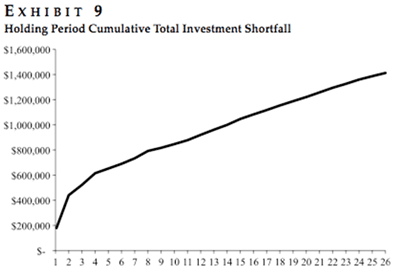When leveraged and inverse ETFs were first launched, many investors weren’t aware of the negative effects that daily rebalancing would have on the long-term performance of those ETFs relative to their benchmarks. Those potential problems are now more widely known, and coverage of leveraged and inverse products often includes the advice that they are best used as trading vehicles rather than investment products (i.e. to avoid investment shortfalls due to rebalancing effects, the holding period for positions using these products should be on the order of days, rather than weeks or months.)
Research in the winter 2010 issue of the Journal of Index Investing suggests that the message still hasn’t gotten through:
“We find that many investors hold their leveraged ETFs for very long periods, at times longer than three months. Further, we calculate the shortfall of such a behavior compared to creating the leverage in a margin account. We find that some ETF investors lose up to 3% of their original investment in just a few weeks, the equivalent of a 50% annualized return. This indicates that investors do not fully understand the risks associated with inappropriately using leveraged and inverse ETFs as long-term investments.”
The problem isn’t with the use of leverage, as such. The graph below, which is from the paper, shows the relative outperformance for one fund (symbol DPK) that would have been achieved by using a margin account instead of a daily rebalancing regime.
Another interesting finding is that rebalancing over other periods (weekly, monthly) improves results slightly, on average, but inconsistently. Some funds experience worse shortfalls at a monthly rebalancing horizon.
There’s a larger point to be made here, of which the matter of rebalancing ETF shortfalls is just one instance. The complexity of modern financial products clearly outstrips the ability of investors to understand them, even when they are relatively “sophisticated” (e.g. the kinds of people willing and able to trade inverse/leveraged products) and are presented with proper disclosures. It’s no fairer to rest all of the blame on individual investors than it is to scold a toddler for burning his hand after you have just explained the physics of exothermic chemical reactions with regard to stovetop ranges.
The problem is either with the products themselves or with the opacity of the disclosures. I’m not disposed toward banning products for being “too complex.” But every incentive on the side of banks, dealers, and other financial institutions is to refuse forever to present risks in sentences of English, instead of evanescent tissues of lawyerly obfuscation. This is something the Consumer Financial Protection Bureau will address, with any luck, for the most widely used consumer products; the public interest would also be served by expanding the scope of plain-language mandates.
By Jared Woodard of CondorOptions.com


















